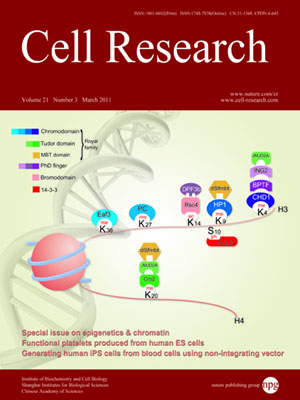
Volume 21, No 3, Mar 2011
ISSN: 1001-0602
EISSN: 1748-7838 2018
impact factor 17.848*
(Clarivate Analytics, 2019)
Volume 21 Issue 3, March 2011: 421-434
REVIEWS
The double face of the histone variant H3.3
Emmanuelle Szenker1,2, Dominique Ray-Gallet1,2 and Geneviève Almouzni1,2
1Institut Curie, Centre de Recherche, Paris F-75248, France
2CNRS, UMR218, Paris F-75248, France
Correspondence: Geneviève Almouzni,(almouzni@curie.fr)
Histone proteins wrap DNA to form nucleosome particles that compact eukaryotic genomes while still allowing access for cellular processes such as transcription, replication and DNA repair. Histones exist as different variants that have evolved crucial roles in specialized functions in addition to their fundamental role in packaging DNA. H3.3 — a conserved histone variant that is structurally very close to the canonical histone H3 — has been associated with active transcription. Furthermore, its role in histone replacement at active genes and promoters is highly conserved and has been proposed to participate in the epigenetic transmission of active chromatin states. Unexpectedly, recent data have revealed accumulation of this specific variant at silent loci in pericentric heterochromatin and telomeres, raising questions concerning the actual function of H3.3. In this review, we describe the known properties of H3.3 and the current view concerning its incorporation modes involving particular histone chaperones. Finally, we discuss the functional significance of the use of this H3 variant, in particular during germline formation and early development in different species.
Cell Research (2011) 21:421-434. doi:10.1038/cr.2011.14; published online 25 January 2011
FULL TEXT | PDF
Browse 2304


